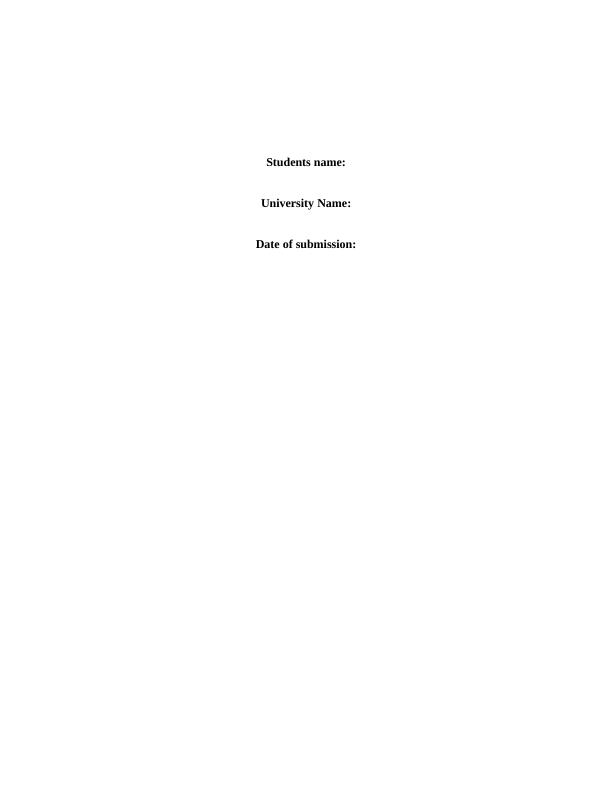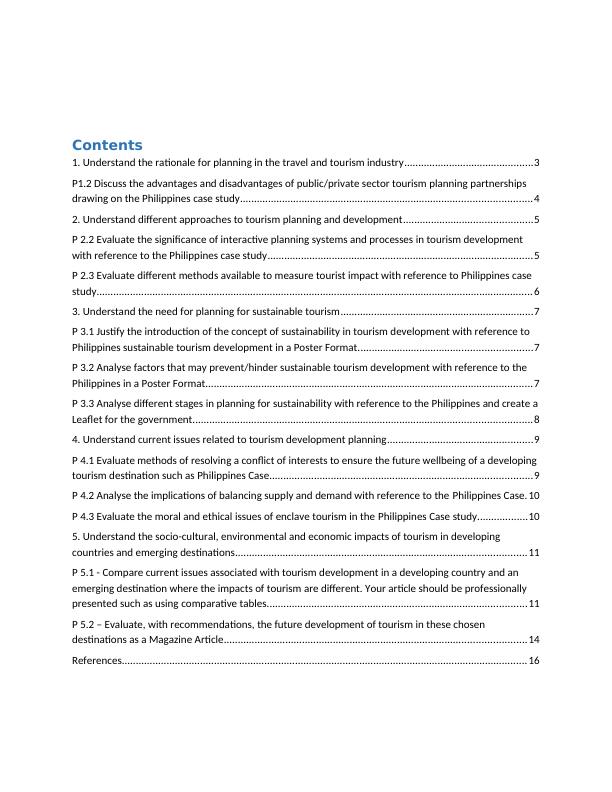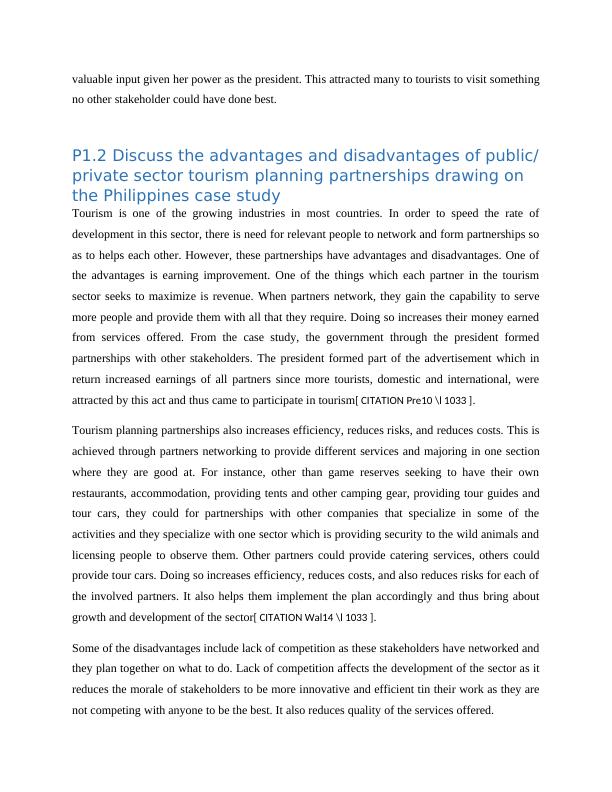Ask a question from expert
Different Stages in Planning for Sustainability
16 Pages5064 Words209 Views
Added on 2020-02-05
Different Stages in Planning for Sustainability
Added on 2020-02-05
BookmarkShareRelated Documents
Students name:University Name:Date of submission:

Contents1. Understand the rationale for planning in the travel and tourism industry..............................................3P1.2 Discuss the advantages and disadvantages of public/private sector tourism planning partnerships drawing on the Philippines case study........................................................................................................42. Understand different approaches to tourism planning and development..............................................5P 2.2 Evaluate the significance of interactive planning systems and processes in tourism development with reference to the Philippines case study...............................................................................................5P 2.3 Evaluate different methods available to measure tourist impact with reference to Philippines case study............................................................................................................................................................63. Understand the need for planning for sustainable tourism.....................................................................7P 3.1 Justify the introduction of the concept of sustainability in tourism development with reference to Philippines sustainable tourism development in a Poster Format..............................................................7P 3.2 Analyse factors that may prevent/hinder sustainable tourism development with reference to the Philippines in a Poster Format.....................................................................................................................7P 3.3 Analyse different stages in planning for sustainability with reference to the Philippines and create aLeaflet for the government.........................................................................................................................84. Understand current issues related to tourism development planning....................................................9P 4.1 Evaluate methods of resolving a conflict of interests to ensure the future wellbeing of a developingtourism destination such as Philippines Case..............................................................................................9P 4.2 Analyse the implications of balancing supply and demand with reference to the Philippines Case.10P 4.3 Evaluate the moral and ethical issues of enclave tourism in the Philippines Case study..................105. Understand the socio-cultural, environmental and economic impacts of tourism in developing countries and emerging destinations........................................................................................................11P 5.1 - Compare current issues associated with tourism development in a developing country and an emerging destination where the impacts of tourism are different. Your article should be professionally presented such as using comparative tables.............................................................................................11P 5.2 – Evaluate, with recommendations, the future development of tourism in these chosen destinations as a Magazine Article............................................................................................................14References.................................................................................................................................................16

1. Understand the rationale for planning in the travel and tourism industryP1.1 Discuss how stakeholders can benefit from planning of tourism developments withreference to the Philippines case study.Stakeholders in the tourism sector plays a very crucial role towards the development of thesector. Stakeholders are the people who are affected from the end results of a project or actionbeing taken. For instance, in the tourism sector, stakeholders include resort and restaurantowners, the government, tour companies, and conservancies and game reserve owners. Thesestakeholders can benefit a lot from planning of tourism development. To begin with, they areinvolved in decision-making first-hand. They get to decide what ought to be done towardsdeveloping the industry, they also get to participate in these decisions which earns them a lot ofsatisfaction with what is being done. For instance, the president of Philippines got theopportunity as a stakeholder to show others how great their land is and thus attract so manytourists to that area. That granted the president as well as other stakeholder the opportunity tomake a decision and see it through on how to improve tourism through having fun activities theycan come to participate in[ CITATION Wal14 \l 1033 ]. Being part of the planning unit as well as implementation benefits stakeholders throughimproved outcome. The more they are involved, the more they are satisfied with the end result.This is because they get a unique opportunity to see through all the plan and thus achieve theoutcome they desire. It also builds trust and increases their commitment something that would belacking if they were not involved in planning. Being part of planning also benefits stakeholdersthrough increasing transparency in the sector. They are aware of all that is happening in theindustry and as such they know how to plan their businesses. They are also not caught bysurprise in instances where some regulations change without their knowhow forcing them toclose down their investments. Rather, they get the opportunity to make the legislations andparticipate in passing them thus being aware of all that is happening to develop theindustry[ CITATION Aap12 \l 1033 ]. Different stakeholders have different inputs they can contribute to the tourism industry.Stakeholders can thus benefit through the valuable input from others which is unique cancontribute a lot towards the industry. For instance, from the case study, the president provided

valuable input given her power as the president. This attracted many to tourists to visit somethingno other stakeholder could have done best.P1.2 Discuss the advantages and disadvantages of public/private sector tourism planning partnerships drawing on the Philippines case studyTourism is one of the growing industries in most countries. In order to speed the rate ofdevelopment in this sector, there is need for relevant people to network and form partnerships soas to helps each other. However, these partnerships have advantages and disadvantages. One ofthe advantages is earning improvement. One of the things which each partner in the tourismsector seeks to maximize is revenue. When partners network, they gain the capability to servemore people and provide them with all that they require. Doing so increases their money earnedfrom services offered. From the case study, the government through the president formedpartnerships with other stakeholders. The president formed part of the advertisement which inreturn increased earnings of all partners since more tourists, domestic and international, wereattracted by this act and thus came to participate in tourism[ CITATION Pre10 \l 1033 ]. Tourism planning partnerships also increases efficiency, reduces risks, and reduces costs. This isachieved through partners networking to provide different services and majoring in one sectionwhere they are good at. For instance, other than game reserves seeking to have their ownrestaurants, accommodation, providing tents and other camping gear, providing tour guides andtour cars, they could for partnerships with other companies that specialize in some of theactivities and they specialize with one sector which is providing security to the wild animals andlicensing people to observe them. Other partners could provide catering services, others couldprovide tour cars. Doing so increases efficiency, reduces costs, and also reduces risks for each ofthe involved partners. It also helps them implement the plan accordingly and thus bring aboutgrowth and development of the sector[ CITATION Wal14 \l 1033 ]. Some of the disadvantages include lack of competition as these stakeholders have networked andthey plan together on what to do. Lack of competition affects the development of the sector as itreduces the morale of stakeholders to be more innovative and efficient tin their work as they arenot competing with anyone to be the best. It also reduces quality of the services offered.

End of preview
Want to access all the pages? Upload your documents or become a member.
Related Documents
Sustainable Tourism Developmentlg...
|19
|4858
|36
Understanding different approaches in the planning of tourism and developmentlg...
|16
|4041
|223
Case Study of Philippine Tourism Industrylg...
|12
|3583
|86
SUSTAINABLE TOURISM DEVELOPMENTlg...
|19
|5683
|339
Sustainable Tourism Development Assignmentlg...
|23
|5311
|229
Report : Assessment On Need To Improve Tourism Industry Of Philippinelg...
|19
|6030
|93